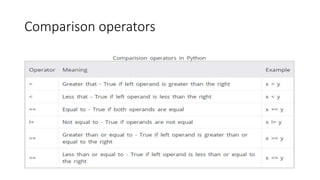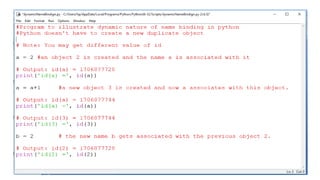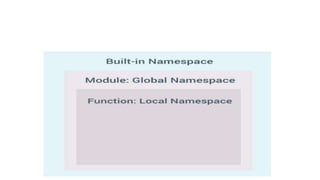Fundamentals of Python Programming
- 2. Introduction to python programming • High level, interpreted language • Object-oriented • General purpose • Web development (like: Django and Bottle), • Scientific and mathematical computing (Orange, SciPy, NumPy) • Desktop graphical user Interfaces (Pygame, Panda3D).
- 3. • Other features of python includes the following: • Simple language which is easier to learn • Free and open source • Portability • Extensible and embeddable • Standard large library
- 4. • Created by Guido van Rossum in 1991 • Why the name Python? • Not after a dangerous snake. • Rossum was fan of a comedy series from late seventies. • The name "Python" was adopted from the same series "Monty Python's Flying Circus".
- 5. Reasons to Choose Python as First Language • Simple Elegant Syntax • Not overly strict • Expressiveness of the language • Great Community and Support
- 6. Installation of Python in Windows • Go to Download Python page on the official site (https://www.python.org/downloads/) and click Download Python 3.6.5 (You may see different version name) • When the download is completed, double-click the file and follow the instructions to install it. • When Python is installed, a program called IDLE is also installed along with it. It provides graphical user interface to work with Python.
- 7. • Open IDLE, Write the following code below and press enter. print("Hello, World!") • To create a file in IDLE, go to File > New Window (Shortcut: Ctrl+N). • Write Python code and save (Shortcut: Ctrl+S) with .py file extension like: hello.py or your-first-program.py print("Hello, World!") • Go to Run > Run module (Shortcut: F5) and you can see the output.
- 10. Second Program
- 12. Few Important Things to Remember • To represent a statement in Python, newline (enter) is used. • Use of semicolon at the end of the statement is optional (unlike languages like C/C++) • In fact, it's recommended to omit semicolon at the end of the statement in Python • Instead of curly braces { }, indentations are used to represent a block
- 13. Python Keywords • Keywords are the reserved words(can not be used as a identifier) in Python • Are case sensitive
- 14. Python Identifiers • Name given to entities like class, functions, variables etc. in Python • Rules for writing identifiers • Can be a combination of letters in lowercase (a to z) or uppercase (A to Z) or digits (0 to 9) or an underscore (_) • myClass, var_1 and print_this_to_screen, all are valid examples • Cannot start with a digit • 1variable is invalid, but variable1 is perfectly fine • Keywords cannot be used as identifiers • Cannot use special symbols like !, @, #, $, % etc. in our identifier • Can be of any length.
- 15. Things to care about • Python is a case-sensitive language. • Variable and variable are not the same. • Multiple words can be separated using an underscore, this_is_a_long_variable • Can also use camel-case style of writing, i.e., capitalize every first letter of the word except the initial word without any spaces • camelCaseExample
- 16. Python Statement • Instructions that a Python interpreter can execute are called statements. • Two types • Single line statement: • For example, a = 1 is an assignment statement • Multiline statement: • In Python, end of a statement is marked by a newline character. • So, how to make multiline statement?
- 17. • Technique1: • make a statement extend over multiple lines with the line continuation character (). • For example: a = 1 + 2 + 3 + 4 + 5 + 6 + 7 + 8 + 9
- 18. • Technique2: • make a statement extend over multiple lines with the parentheses ( ) • For example: a = (1 + 2 + 3 + 4 + 5 + 6 + 7 + 8 + 9)
- 19. • Technique3: • make a statement extend over multiple lines with the brackets [ ] and braces { }. • For example: colors = ['red', 'blue', 'green']
- 20. • We could also put multiple statements in a single line using semicolons, as follows a = 1; b = 2; c = 3
- 21. Python Indentation • Most of the programming languages like C, C++, Java use braces { } to define a block of code • Python uses indentation • A code block (body of a function, loop etc.) starts with indentation and ends with the first un-indented line
- 24. Error due to incorrect indentation
- 25. Python Comments • To make the code much more readable. • Python Interpreter ignores comment. • Two types of comment is possible in python: • Single line comment and • Multi-line comment
- 26. Single line comment • In Python, we use the hash (#) symbol to start writing a comment. • It extends up to the newline character
- 27. Multi-line comments • Two way: • By using # sign at the beginning of each line #This is a long comment #and it extends #to multiple lines • By using either ‘ ‘ ‘ or “ “ “ (most common) """This is also a perfect example of multi-line comments"""
- 28. Python Variable • a variable is a named location used to store data in the memory. • Alternatively, variables are container that hold data which can be changed later throughout programming
- 29. Declaring Variables • In Python, variables do not need declaration to reserve memory space. • The "variable declaration" or "variable initialization" happens automatically when we assign a value to a variable. • We use the assignment operator = to assign the value to a variable.
- 30. Assigning Values to variables
- 32. Changing value of a variable
- 34. Assigning same value to the multiple variable
- 36. Assigning multiple values to multiple variables
- 38. Constants • Value that cannot be altered by the program during normal execution. • In Python, constants are usually declared and assigned on a module • And then imported to the file
- 42. Rules and Naming convention for variables and constants • Create a name that makes sense. Suppose, vowel makes more sense than v. • Use camelCase notation to declare a variable • For example: myName, myAge, myAddress • Use capital letters where possible to declare a constant • For example: PI,G,MASS etc.
- 43. • Never use special symbols like !, @, #, $, %, etc. • Don't start name with a digit. • Constants are put into Python modules • Constant and variable names should have combination of letters in lowercase (a to z) or uppercase (A to Z) or digits (0 to 9) or an underscore (_). • For example: snake_case, MACRO_CASE, camelCase, CapWords
- 44. Literals • Literal is a raw data given in a variable or constant. In Python, there are various types of literals they are as follows: • Numeric literals • String literals • Boolean literals • Special literals
- 45. Numeric Literals
- 47. String Literals
- 49. Docstrings
- 57. Data Types • In python data types are classes and variables are instance (object) of these classes • Different types of data types in python are: • Python numbers • Python lists • Python tuples • Python strings • Python sets • Python dictionary
- 58. Python Numbers
- 60. Python List • Ordered sequence of items • Can contain heterogeneous data • Syntax: • Items separated by commas are enclosed within brackets [ ] • Example: a= [1,2.2,'python']
- 61. Extracting elements from the list
- 63. • Note: Lists are mutable, meaning, value of elements of a list can be altered.
- 64. Python Tuple • Same as list but immutable. • Used to write-protect the data • Syntax: • Items separated by commas are enclosed within brackets ( ) • Example: • t = (5,'program', 1+3j)
- 69. Python Strings • use single quotes or double quotes to represent strings. • Multi-line strings can be denoted using triple quotes, ''' or """. • Example: s = "This is a string" s = '''a multiline string’’’ • Strings are also immutable.
- 72. Python Set • Unordered collection of unique items • defined by values separated by comma inside braces { }
- 74. • Set have unique values. They eliminate duplicates. • Example:
- 75. • Since, set are unordered collection, indexing has no meaning. • Hence the slicing operator [] does not work. • Example:
- 76. Python Dictionary • An unordered collection of key-value pairs. • Must know the key to retrieve the value. • Are defined within braces {} with each item being a pair in the form key: value • Key and value can be of any type
- 79. Conversion between data types • Conversion can be done by using different types of type conversion functions like: • int(), • float(), • str() etc.
- 80. int to float
- 81. float to int
- 82. To and form string
- 83. convert one sequence to another
- 84. • To convert to dictionary, each element must be a pair:
- 85. Python Type Conversion and Type Casting • The process of converting the value of one data type (integer, string, float, etc.) to another data type is type conversion • Python has two types of type conversion. • Implicit Type Conversion • Explicit Type Conversion
- 86. • Type Conversion is the conversion of object from one data type to another data type • Implicit Type Conversion is automatically performed by the Python interpreter • Python avoids the loss of data in Implicit Type Conversion • Explicit Type Conversion is also called Type Casting, the data types of object are converted using predefined function by user • In Type Casting loss of data may occur as we enforce the object to specific data type
- 87. Implicit Type Conversion • Automatically converts one data type to another data type • Always converts smaller data type to larger data type to avoid the loss of data
- 89. Problem in implicit type conversion
- 91. Explicit Type Conversion • Users convert the data type of an object to required data type. • Predefined functions like int(), float(), str(), etc. are to perform explicit type conversion • Is also called typecasting because the user casts (change) the data type of the objects. • Syntax : • (required_datatype)(expression) • Int(b)
- 92. Example
- 94. Python Input, Output and Import • Widely used functions for standard input and output operations are: • print() and • input()
- 95. Python Output Using print() function
- 96. Output formatting • Can be done by using the str.format() method • Is visible to any string object • Here the curly braces {} are used as placeholders. We can specify the order in which it is printed by using numbers (tuple index).
- 97. Example
- 98. • We can even use keyword arguments to format the string
- 99. • We can even format strings like the old printf() style used in C • We use the % operator to accomplish this
- 100. Input() function • input() function to take the input from the user. • The syntax for input() is : • input([prompt]) • where prompt is the string we wish to display on the screen. • It is optional
- 101. • Entered value 10 is a string, not a number. • To convert this into a number we can use int() or float() functions • This same operation can be performed using the eval(). It can evaluate expressions, provided the input is a string.
- 102. Python Import • When our program grows bigger, it is a good idea to break it into different modules. • A module is a file containing Python definitions and statements. • Python modules have a filename and end with the extension .py • Definitions inside a module can be imported to another module or the interactive interpreter in Python • We use the import keyword to do this
- 104. • import some specific attributes and functions only, using the from keyword.
- 105. Python Operators • Operators are special symbols in Python that carry out arithmetic or logical computation. • The value that the operator operates on is called the operand. • For example: >>> 2+3 5 • Here, + is the operator that performs addition. • 2 and 3 are the operands and 5 is the output of the operation.
- 106. Arithmetic operators
- 107. Example
- 108. Comparison operators
- 110. Logical operators
- 112. Bitwise operators • Bitwise operators act on operands as if they were string of binary digits. It operates bit by bit, hence the name. • For example, 2 is 10 in binary and 7 is 111. • In the table below: Let x = 10 (0000 1010 in binary) and y = 4 (0000 0100 in binary)
- 114. Assignment operators • Assignment operators are used in Python to assign values to variables. • a = 5 is a simple assignment operator that assigns the value 5 on the right to the variable a on the left. • There are various compound operators in Python like a += 5 that adds to the variable and later assigns the same. • It is equivalent to a = a + 5.
- 116. Special operators • identity operator • membership operator
- 117. Identity operators • is and is not are the identity operators in Python. • They are used to check if two values (or variables) are located on the same part of the memory. • Two variables that are equal does not imply that they are identical.
- 119. Membership operators • in and not in are the membership operators in Python • They are used to test whether a value or variable is found in a sequence (string, list, tuple, set and dictionary). • In a dictionary we can only test for presence of key, not the value
- 121. Python Namespace and Scope • Name (also called identifier) is simply a name given to objects. • Everything in Python is an object • Name is a way to access the underlying object. • For example: • when we do the assignment a = 2, here 2 is an object stored in memory and a is the name we associate it with • We can get the address (in RAM) of some object through the built-in function, id()
- 125. A name could refer to any type of object
- 126. Functions are objects too, so a name can refer to them as well
- 127. What is a Namespace in Python? • namespace is a collection of names. • Help to eliminate naming collision/naming conflict
- 128. • A namespace containing all the built-in names is created when we start the Python interpreter and exists as long we don't exit • Each module creates its own global namespace • Modules can have various user defined functions and classes. • A local namespace is created when a function is called, which has all the names defined in it. • Similar, is the case with class
- 130. Python Variable Scope • All namespaces may not be accessible from every part of the program • Scope is the portion of the program from where a namespace can be accessed directly without any prefix
- 131. • At any given moment, there are at least three nested scopes. • Scope of the current function which has local names • Scope of the module which has global names • Outermost scope which has built-in names • When a reference is made inside a function, the name is searched in the local namespace, then in the global namespace and finally in the built-in namespace. • If there is a function inside another function, a new scope is nested inside the local scope.
- 135. Thank You !


















![• Technique3:
• make a statement extend over multiple lines with the brackets [ ] and braces {
}.
• For example:
colors = ['red',
'blue',
'green']](https://image.slidesharecdn.com/python-180627055143/85/Fundamentals-of-Python-Programming-19-320.jpg)

























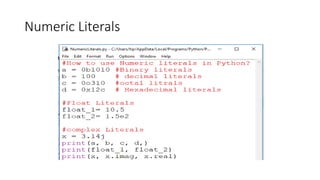








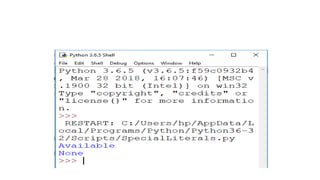
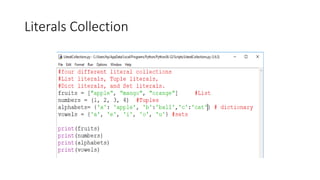
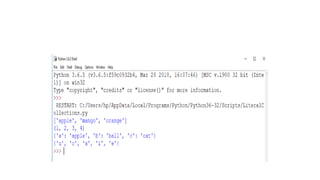



![Python List
• Ordered sequence of items
• Can contain heterogeneous data
• Syntax:
• Items separated by commas are enclosed within brackets [ ]
• Example: a= [1,2.2,'python']](https://image.slidesharecdn.com/python-180627055143/85/Fundamentals-of-Python-Programming-60-320.jpg)

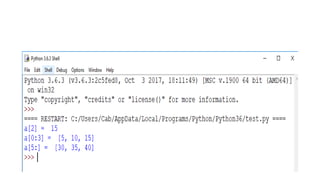






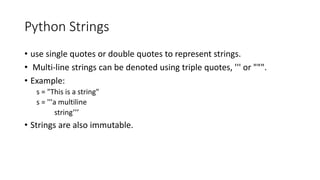





![• Since, set are unordered collection, indexing has no meaning.
• Hence the slicing operator [] does not work.
• Example:](https://image.slidesharecdn.com/python-180627055143/85/Fundamentals-of-Python-Programming-75-320.jpg)
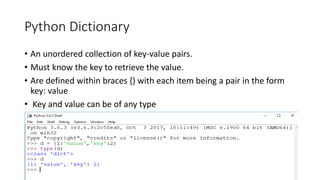
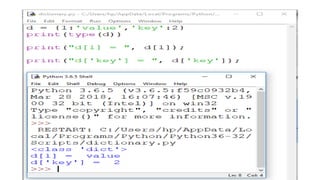















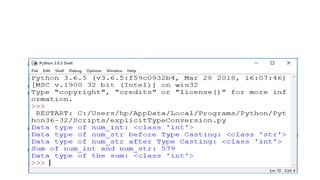






![Input() function
• input() function to take the input from the user.
• The syntax for input() is :
• input([prompt])
• where prompt is the string we wish to display on the screen.
• It is optional](https://image.slidesharecdn.com/python-180627055143/85/Fundamentals-of-Python-Programming-100-320.jpg)







